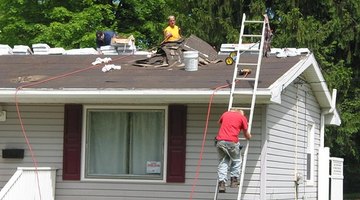Tar Paper Vs. Tyvek
When it comes to using protective barriers in construction work, some believe it is a matter of Tyvek versus tar paper. Those who work with the materials have their preferences, but the truth is, each is effective in its own way. Although both may be beneficial in construction, in other industries, Tyvek is the material that is used in the most diverse number of ways.
Identify

Tar paper is heavy duty paper that has gone through a tar saturation process. It is most commonly used in roofing construction because it acts as an effective barrier to rain and atmospheric moisture. In the United States, tar paper is typically sold in 15- or 30-pound rolls that are three feet wide and either 50 or 100 feet long.
Tyvek is a synthetic material that is durable and difficult to tear. This lightweight DuPont product is also used in construction. In some cases, Tyvek is used in place of tar paper. It is one of the reasons DuPont is recognized globally for their barrier technology. Tyvek comes in rolls that are eight and 10 feet wide, and it is used in various industries.
Function
Both Tyvek and tar paper can be used to successfully protect against water, moisture and other elements related to the climate. Some refer to tar paper as roofing felt, and Tyvek is often referred to as house wrap. Both can be used as residential protective barriers. When used as a house wrap, Tyvek provides more resistance to wind and water since the wider rolls will require fewer seams.
Benefits
Tar paper is a popular and effective choice for residential roofing. A layer can be of particular help with making sure asphalt shingles don't stick to the roof sheathing. Tyvek is used for purposes other than construction. It is used in the manufacturing of envelopes and various protective covers, such as furniture and automobile covers. Tyvek is also recyclable and among the 5.5 million tons of commodities that Waste Management recycles each year.
Considerations
In some instances, Tyvek and tar paper have been known to work well together. Contractors have discussed applying Tyvek as a house wrap, followed by a layer of tar paper. This allows the wrap to breath while at the same time providing a protective barrier to keep the water and moisture out.
Warning
When using tar paper on roofing jobs, it is important to recognize the limitations of the material. Tar paper may buckle if it gets wet prior to installation. If that happens, flatten it out and let it dry before continuing to work with it. Using Tyvek with cedar siding is not recommended since cedar appears to break down the material.
References
Writer Bio
Charm Baker resides in California, where she earned a journalism degree and began writing well over fifteen years ago. She has worked as both a staff and freelance writer for publications such as: Los Angeles Trade Winds, LA Kids, Minority Advancement Profile, Business Training Schools, Inc. and 365iVibe.com.
Photo Credits
- Image by Flickr.com, courtesy of National Institute for Occupational Safety and Health (NIOSH)
More Articles



